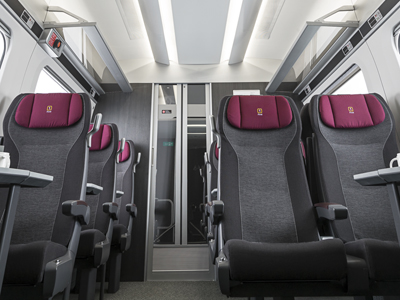
Dan Jenkins and Carl Harvey describe how a full-size mock up helped designers to test and tweak every detail of the new intercity express train.
Intercity trains act as living spaces for their passengers. With daily commuters spending around 200 and 500 hours of time a year in the train, passenger spaces need to be comfortable and allow all passengers to make the best use of their time.
This requirement for comfort needs to be considered in light of the intensive usage and the wear and tear that comes with high passenger numbers. Accordingly, the design of the train is of critical importance, particularly in the light of the long life spans of the trains which is typically between 25 and 40 years.
As with most design projects, the cost of design change increases, almost exponentially, as the train design process progresses. Therefore, it is imperative that the design is optimised and agreed as early in the design project as possible. This process of agreement involves accommodating the views of a multitude of stakeholders.
From a passenger perspective, trains need to be truly inclusive. The design has to consider the needs of both commuters and recreational users, those travelling alone, wishing to use the journey time to catch up on work, as well as families with small children. Users may have a range of mobility requirements; they may be in a wheelchair, have limited mobility or dexterity, or any number of sensory impairments.
From a staff perspective, the train has to be a safe, comfortable and pleasant place to work for both the train crew and the drivers. There also needs to be the flexibility to operate the train in a number of ways to account for changing working practices.
Fortunately, there is a wide range of guidance available to inform the design. Regulations describing the requirements of persons with reduced mobility provide measurable and testable design criteria, such as the acceptable height and location of door controls. There is also a wide range of stakeholder groups that are keen to participate in the design process. These include passenger groups, train driver unions, representatives of train operating companies and cyclists.
From a physical and engineering perspective, a number of constraints also shape the design. The train width, height and carriage length are dictated by the existing rail infrastructure. Likewise, the route demand and track availability also place a requirement on the number of seats within the train.
The result of these constraints and considerations is that a careful balance must be struck to ensure both the number of seats within the train is maximised and the space meets the needs and wishes of the diverse user population.
Accordingly, the role of human factors in the project is clear and is split between the tasks of stakeholder consultation, compliance assessment, and design optimisation.
Having just completed this role for the new Intercity Express Programme (IEP) train, we’d like to share a few insights.
The wider project involves the design and manufacture of 122 new trains for the UK’s East Coast and Great Western mainlines. The first trains are planned to go into service in 2017, increasing capacity and reducing journey times.
The human factors involvement in the design process broadly follows this format:
- Requirements capture, including target audience description, extraction of relevant clauses from the train technical specification and the identification of applicable regulations and standards.
- Assessment of CAD data (2D and 3D) for compliance against the identified regulations and standards and to assess compatibility with the target audience and the technical specification.
- Evaluation of low-fidelity partial rigs and mock ups such as the cab control console.
- Evaluation of full-sized low-fidelity spatial mock up.
- Evaluation of full-sized high-fidelity mock up.
- Demonstration and documention of compliance.
While the requirements for trains are relatively well prescribed, occasional ambiguity still exists. Instances where requirements are neither measurable nor testable provide the greatest challenge.
The physical full-sized mock ups were found to be invaluable in supporting the human factors tasks. While CAD drawings proved to be the most effective way of demonstrating compliance against measurable requirements, the mock up proved to be best suited to more subjective assessments.
The size and scale of the mock up was a clear advantage in this. Multiple stakeholders could be engaged collectively and potential issues could be discussed in situ. Stakeholders had the opportunity to perform tasks in the train such as moving through the train with a catering trolley or evacuating the driving position in response to an emergency.
Alongside more informal assessments, structured, task-based assessments were also conducted. A detailed hierarchical task analysis model of the train driving task was conducted. This formed the basis of a structured evaluation of the cab control layout to ensure compatibility with the driving task. New approaches were also developed in order to test the suitability of the cab against instances of glare.
The mock up proved to be an incredibly valuable part of the design process. It acted as a hub for discussion and stakeholder engagement.
Furthermore, the environment was immersive enough for the stakeholders to simulate routine and emergency tasks allowing them to identify opportunities for improvement and confirm acceptance of the layout.
By Dan Jenkins, Research Lead at DCA Design International, & Carl Harvey, Interiors and Mock up Manager at Hitachi Rail Europe
This article first appeared in Issue 533 of The Ergonomist, November 2014.
